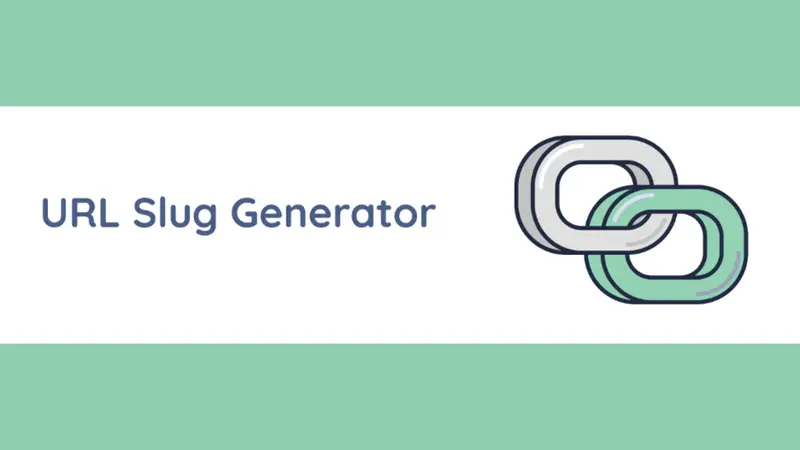Convert your sentences into SEO-friendly URLs with this free slug generator.
Copied to Clipboard!
How to Use the SEO-Friendly URL/Slug Generator Tool:
Step 1: Input Sentence
Begin by entering the sentence or phrase that you want to convert into an SEO-friendly URL.
This could be a compelling headline or a descriptive phrase related to your content. Consider phrases like:
- "Enhance Your Online Presence with Engaging Content"
- "The Art of Crafting SEO-Optimized Blog Posts"
Step 2: Select Separator Option
Choose the separator that best suits your URL structure.
Select either a dash (-) or an underscore (_) to separate the words in your sentence.
This choice can impact the readability and aesthetics of your URL.
Step 3: Choose Additional Options
Explore the additional options available to customize your URL:
- Decide whether to remove numbers from the URL for a cleaner link.
- Opt to eliminate stop words from the sentence, streamlining the URL and emphasizing essential keywords.
Step 4: Generate URL
Click on the "Generate URL" button to create the SEO-friendly URL.
The tool automatically formats your sentence into a well-structured URL, considering the chosen separator and any preferences for removing numbers or stop words.
Step 5: Copy to Clipboard
After generating the SEO-friendly URL, you have the option to copy it to your clipboard for easy sharing and use. Follow these simple steps to copy the URL:
- Click on the "Copy to Clipboard" button.
- The generated URL will be automatically copied to your clipboard.
- You can then paste the URL wherever you need it, such as in your website content or social media posts.
Step 6: Reset the Form
If you need to start over or make changes to your input, the Reset button allows you to clear the form easily.
Here's how you can reset the form:
- Click on the "Reset" button.
- The input field will be cleared, and the generated URL will be removed.
- This provides you with a fresh starting point to input a new sentence and customize the URL generation options.How can the Reset button simplify the process of refining your SEO-friendly URL creation?
Additional Tips for Efficient Copying and Resetting:
- Ensure that the copied URL is pasted accurately to avoid any potential errors in sharing.
- Use the Reset button to experiment with various sentences and options until you find the most suitable SEO-friendly URL for your content.
By utilizing the Copy and Reset buttons effectively, you can streamline the process of creating and sharing SEO-friendly URLs.
This ensures that your content is easily accessible and shareable with your target audience.
NovaInformer Slug Generator Examples
| Topic | SEO-Friendly URL Output |
|---|---|
| Top 10 Tips for Effective Content Marketing | top-10-tips-for-effective-content-marketing |
| The Impact of Social Media on Modern Businesses | the-impact-of-social-media-on-modern-businesses |
| How to Enhance Your Website's User Experience | how-to-enhance-your-websites-user-experience |
| The Role of Artificial Intelligence in Digital Transformation | the-role-of-artificial-intelligence-in-digital-transformation |
| Creating a Successful E-commerce Strategy for Your Business | creating-a-successful-e-commerce-strategy-for-your-business |
| 10 Must-Read Books for Entrepreneurs in 2022 | 10-must-read-books-for-entrepreneurs-in-2022 |
| Understanding the Impact of $1000 Investment in Tech Stocks | understanding-the-impact-of-1000-investment-in-tech-stocks |
| Key Strategies for Boosting Your Business Revenue by 25% | key-strategies-for-boosting-your-business-revenue-by-25 |
| The Evolution of Mobile Technology: A $5 Billion Industry | the-evolution-of-mobile-technology-a-5-billion-industry |
| How to Launch a Successful Product in a Competitive $50 Billion Market | how-to-launch-a-successful-product-in-a-competitive-50-billion-market |
Through the SEO-Friendly URL Generator Tool, you can seamlessly create well-formatted URLs for various topics, including those that contain numbers and symbols.
This enables you to optimize your content for improved search engine visibility and user experience.
FAQ About The Slug Generator
What is a slug?
A slug, in the context of a URL, refers to the segment of a web address that identifies a specific page or post in a human-readable format.
It is the user-friendly part of the URL that comes after the domain name and provides a brief description of the content on the page.
Slugs are typically created to make URLs more readable, descriptive, and SEO-friendly. It helps both users and search engines understand the context of the linked content.
In simpler terms, a slug is the part of a URL that has words or a phrase relevant to the content of the webpage.
This makes it easier for users to interpret the topic of the page just by looking at the URL.
For instance, in the URL "https://www.example.com/blog/seo-friendly-url-best-practices", the slug is "seo-friendly-url-best-practices". It gives users a clear idea about the content of the linked webpage.
Slugs play a crucial role in enhancing the user experience and optimizing a website for search engines, thereby improving its visibility and accessibility online.
What is a URL Slug Generator?
A URL slug generator is a tool or function that automatically creates SEO-friendly URL slugs from provided titles or phrases.
It ensures that the resulting URLs are optimized for search engines.
It aids in the process of generating clean, readable, and relevant slugs that contribute to improved search engine visibility and user experience.
How important is a Slug Generator for SEO?
The role of a slug generator in SEO cannot be overstated.
By facilitating the creation of well-structured and keyword-rich URL slugs, it significantly enhances a website's search engine optimization efforts.
It ensures that URLs are concise, descriptive, and easy to read, thereby positively impacting the website's visibility on search engine result pages (SERPs) and improving the overall user experience.
What is the Difference between a URL and a Slug in the Context of a Slug Generator?
In the context of a slug generator, a URL represents the complete web address used to access a specific web page, while a slug is a component of the URL that identifies the page's content.
The slug is derived from the title or a relevant phrase and is often created using the slug generator to ensure that it is optimized for search engines.
The table below further illustrates this difference:
| URL | Slug |
|---|---|
| https://www.example.com/blog/seo-friendly-url-best-practices | seo-friendly-url-best-practices |
SEO-Friendly URL Best Practices: Tips for Using a Slug Generator Effectively
To optimize the use of a slug generator and create SEO-friendly URLs, consider the following best practices:
- Utilize relevant keywords in the slug to enhance search engine visibility.
- Keep the slug concise and descriptive for an improved user experience.
- Use hyphens to separate words in the slug, facilitating readability for both users and search engines.
- Avoid incorporating unnecessary parameters or symbols that may complicate the URL structure and reduce its SEO effectiveness.
Which is the Best: HTTP or HTTPS URLs?
When comparing HTTP and HTTPS URLs, it's important to consider the following aspects:
- Security Enhancement: HTTPS URLs offer advanced security features through data encryption, ensuring secure data transmission between the user's browser and the website server.
- Trust and Credibility: The implementation of HTTPS enhances user trust and credibility, as it protects sensitive information from potential cyber threats and unauthorized access.
- SEO Impact: Search engines prioritize HTTPS URLs, considering them more secure and reliable, which can positively influence search rankings.
Should I Use Sub Folder or Subdomain?
In the context of organizing website content, the use of subfolders and subdomains offers distinct benefits:
Subfolders:
- Facilitate a clear hierarchical structure within the main domain, aiding search engines in understanding the relationships between different sections of the website.
- Contribute to improved website architecture, ensuring better indexing and ranking of the entire domain.
- Promote a unified brand presence and simplified management of website content.
Subdomains:
- Enable the creation of separate entities under the main domain, suitable for distinct and independent content sections.
- Provide flexibility in hosting diverse content types or services without impacting the main domain's performance.
- Support targeted marketing strategies and specific audience segmentation for enhanced user experience.
Should I Use Lowercase Characters in URLs?
The practice of using lowercase characters in URLs offers several advantages:
- Ensures consistency and minimizes the risk of encountering duplicate content issues, as search engines treat uppercase and lowercase characters differently.
- Enhances the readability and accessibility of URLs for users and search engines, contributing to a more user-friendly online experience.
- Promotes effective organization and indexing of web content, leading to improved SEO performance and streamlined website management.
By considering these factors and best practices, you can make informed decisions about the implementation of HTTP vs.
HTTPS URLs and the use of subfolders and subdomains, as well as the use of lowercase characters in URLs, to optimize your website's visibility and user experience.
>>>Check out our top-class mortgage calculator<<<



